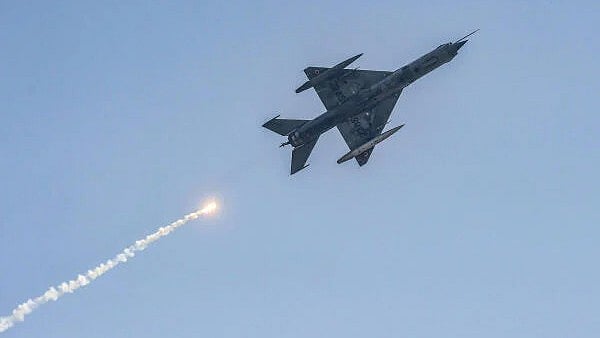
Representative image of Indian Air Force's Mig-21.
Credit: PTI Photo
Twenty-two years ago, on a cloudy August day at Ambala, septuagenarian George Fernandes took a ride in a MiG-21, sporting a G-suit. The Atal Bihari Vajpayee government was at the receiving end of public anger after a series of crashes killing young pilots and Fernandes, as the defence minister, had to do something to repose people’s faith in an aircraft that was the mainstay of the Indian Air Force since the 1960s but unfortunately earned monikers like “flying coffin” and “widow maker”.
After a 25-minute sortie, a visibly relieved minister said that the flight had been intended to remove negative perceptions about the aircraft from people’s minds. The messaging quelled the discontent for some time. A few months passed by peacefully before the next fatal MiG-21 crash.
For decades, the MiG-21s (NATO name: Fishbed) have been painted as villains, though experts point out that the fault lies with an inadequate training platform and the Centre’s procrastination in getting the advanced jet trainer, which came two decades behind schedule.
In the early days when the number of MiG-21 squadrons was limited, only experienced pilots flew the aircraft, and the accident rate was low. As squadron numbers grew, relatively younger pilots were put in the cockpit of an unforgiving platform.
According to the IAF historian Anchit Gupta, the force had little option but to send young pilot officers to MiG-21 squadrons even though the training they received was not enough to go straightaway to a combat jet that had landing speeds of more than 300 km per hour. “Between 1985 and 2005, as many as 63 MiG-21s crashed with either Pilot Officers or Flying Officers at the controls. Forty-five of those crashes were fatal. A generation of young IAF pilots was lost," Gupta wrote in a social media post.
Notwithstanding the mishaps, the IAF continued with MiG-21 in the absence of an alternative. In the 1990s, it was decided to upgrade 125 of these fighters to MiG-21 BIS with better radar, avionics and other systems, even though the engine and airframe remained the same. The upgraded ones flew for another 20-plus years before age caught up with the flying birds.
The last two MiG-21 BIS squadrons will bid adieu next month, bringing down the curtains on the mighty jet’s journey in the IAF. Unfortunately, the sunset moment will also mark the lowest squadron strength for the IAF with only 29 units as against the sanctioned 42.5 squadrons. This comes at a time when China and Pakistan have been boosting their air power steadily, with the communist country having more than 2100 combat aircraft.
The dilly-dallying seen in buying the Hawk Advanced Jet Trainer 30 years ago is visible even today. This time it is about finding a replacement for the MiG-21s. The delivery of Tejas Light Combat Aircraft is hugely delayed, the latest irritant being the US major General Electric’s failure to supply the engines in time. More than 20 years have been wasted to get 6-7 squadrons of medium multi-role combat jets to replace some of the MiGs.
The UPA government spent a decade carrying out a global tender and shortlisting the French Rafale as the chosen platform for the 126 Medium Multi-Role Combat Aircraft (MMRCA) programme. In the next 11 years, the NDA government under Narendra Modi cancelled the MMRCA tender; made emergency procurement of two squadrons of Rafale combat jets and announced the Multi Role Fighter Aircraft (MRFA) programme to buy 114 fighter jets, but the programme has not moved much beyond the initial tender.
Russia and the US have offered India the expensive fifth-generation fighter aircraft, like the Su-57 and the F-35, respectively. Defence Secretary R K Singh, however, said that no formal consultation was going on with any of them, as New Delhi was keen to develop its own fifth-generation Advanced Medium Combat Aircraft.
Meanwhile, the IAF will fight with “whatever we have”, Air Chief Marshal A P Singh said, amid the humming and hawing.
